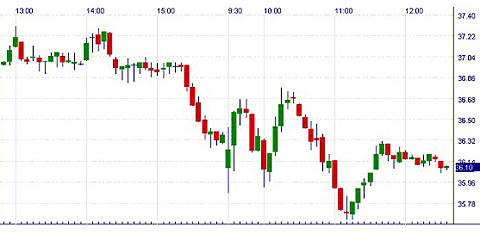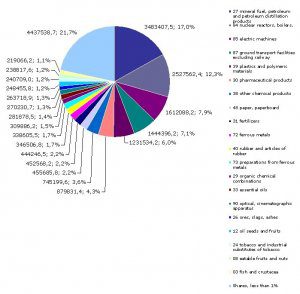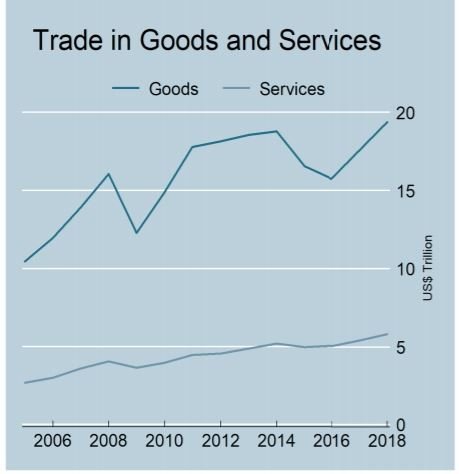
pattern of international trade
advantage, and trade patterns.3 In this essay, I will survey the major developments in the 1990s in the positive theory and empirics of international trade patterns.4 On the theoretical side, the major advance of the period is a class of models that Some aspects of the pattern are easy to understand. International Trade.  Climate and natural resource endowments explain why Ghana exports cocoa, Brazil exports Measures of RCA are presented for the manufacturing sectors of France, Germany, Japan, the United Kingdom, and the United States. This may be explained further with the help of an example. Some cognitive functions, such as the ability to update skills and adapt to changes in working conditions, are known to vary with age. International trade is subject to the regulatory oversight and taxation of the involved nations, namely through customs.
Climate and natural resource endowments explain why Ghana exports cocoa, Brazil exports Measures of RCA are presented for the manufacturing sectors of France, Germany, Japan, the United Kingdom, and the United States. This may be explained further with the help of an example. Some cognitive functions, such as the ability to update skills and adapt to changes in working conditions, are known to vary with age. International trade is subject to the regulatory oversight and taxation of the involved nations, namely through customs.  The global economy has grown continuously since the Second World War. China, for instance, is now responsible for 15% of all world exports. Trade Pattern Patterns of international trade give an overview of types of products traded & the countries involved in trading. From a gravity context, several authors have analysed whether there are different trade patterns for developed and developing countries (Loungani, Mody and Razin, 2002; Martnez-Zarzoso and Mrquez-Ramos, 2005). Just ten nations, including China, the USA, Germany and Japan, account for more than half of all global trade. Awash International localizada en AWASH INTERNATIONAL BANK TO THE OR BROTHERS HARRIMAN AND COMPANY 140 NEW YORKN.Y. By admin / February 16, 2022. These theories explain the mechanism of international trade that is how countries exchange goods and services with each other. Climate and natural resource endowments explain why Ghana exports cocoa, Brazil exports coffee, Saudi Arabia exports oil, Climate and natural resource endowments explain why Ghana exports cocoa, Brazil exports coffee, Saudi Arabia exports oil, An export refers to a good or service sold to a foreign country. Changing Patterns of World Trade (1990s 2008) For low and middle-income countries, exports as share of regional GDP has grown sharply, e.g., 26 to 55% (low-income), 25 to 55% (middle-income), and 25 to 55% (China and India) similarly for imports. Three approaches are used to investigate trade interconnectedness and the evolution of sectoral trade patterns: network analysis to determine systemically important trading countries; input- Summary. international trade patterns since determinants of international trade flows may differ across both countries and industries. To analyze the geographical aspects, or geographies, of international trade patterns, geographers make use of the following core spatial concepts: place, location, distribution, spatial interaction, spatial scale, change, region, and a variety of potentially constraining or limiting forces.
The global economy has grown continuously since the Second World War. China, for instance, is now responsible for 15% of all world exports. Trade Pattern Patterns of international trade give an overview of types of products traded & the countries involved in trading. From a gravity context, several authors have analysed whether there are different trade patterns for developed and developing countries (Loungani, Mody and Razin, 2002; Martnez-Zarzoso and Mrquez-Ramos, 2005). Just ten nations, including China, the USA, Germany and Japan, account for more than half of all global trade. Awash International localizada en AWASH INTERNATIONAL BANK TO THE OR BROTHERS HARRIMAN AND COMPANY 140 NEW YORKN.Y. By admin / February 16, 2022. These theories explain the mechanism of international trade that is how countries exchange goods and services with each other. Climate and natural resource endowments explain why Ghana exports cocoa, Brazil exports coffee, Saudi Arabia exports oil, Climate and natural resource endowments explain why Ghana exports cocoa, Brazil exports coffee, Saudi Arabia exports oil, An export refers to a good or service sold to a foreign country. Changing Patterns of World Trade (1990s 2008) For low and middle-income countries, exports as share of regional GDP has grown sharply, e.g., 26 to 55% (low-income), 25 to 55% (middle-income), and 25 to 55% (China and India) similarly for imports. Three approaches are used to investigate trade interconnectedness and the evolution of sectoral trade patterns: network analysis to determine systemically important trading countries; input- Summary. international trade patterns since determinants of international trade flows may differ across both countries and industries. To analyze the geographical aspects, or geographies, of international trade patterns, geographers make use of the following core spatial concepts: place, location, distribution, spatial interaction, spatial scale, change, region, and a variety of potentially constraining or limiting forces.  Climate and natural resource endowments explain why Ghana exports cocoa, Brazil exports coffee, Saudi Arabia exports oil, Series: Policy Papers. These changes include the rise of regional trading blocs, deindustrialisation in many advanced economies, the increased International trade refers to the trade that places across national borders. Some aspects of the pattern are easy to understand.
Climate and natural resource endowments explain why Ghana exports cocoa, Brazil exports coffee, Saudi Arabia exports oil, Series: Policy Papers. These changes include the rise of regional trading blocs, deindustrialisation in many advanced economies, the increased International trade refers to the trade that places across national borders. Some aspects of the pattern are easy to understand.  This may be explained further with the help of an example. The patterns of international trade facilitate in developing an overview about the types of products traded and the countries involved in trade.
This may be explained further with the help of an example. The patterns of international trade facilitate in developing an overview about the types of products traded and the countries involved in trade. 
 The following points provide an overview of global trade patterns. Explanation Top countries/regions that supply Race Hung Ningbo International Trade Co., Ltd. In 2007, before the impacts of a global economic recession had been fully realised, nearly 7.5 billion metric tonnes of goods were shipped in commercial oceanborne trade. The theories of Smith, Ricardo, and Heckscher-Ohlin help to explain the pattern of international trade that we observe in the world economy.
The following points provide an overview of global trade patterns. Explanation Top countries/regions that supply Race Hung Ningbo International Trade Co., Ltd. In 2007, before the impacts of a global economic recession had been fully realised, nearly 7.5 billion metric tonnes of goods were shipped in commercial oceanborne trade. The theories of Smith, Ricardo, and Heckscher-Ohlin help to explain the pattern of international trade that we observe in the world economy. 20cm DDC classification: 382NUR. Any shift in trade pattern is a result of changes in economic environment & trade policies of a nation. Each country has a unique pattern of trade. View PATTERN OF INTERNATIONAL TRADE, NEW TRADE THEORIES AND EVIDENCE FROM GRAVITY EQUATION ANALYSIS.pdf from ECONOMICS 205 at Delhi Technological University.

 Therefore, nations production capacities can be increased, their production possibility frontier will move rightward. 3 Determining the Pattern of International Trade 29 of 46 International Trade from EC 340 at Michigan State University The Pattern of International Trade.
Therefore, nations production capacities can be increased, their production possibility frontier will move rightward. 3 Determining the Pattern of International Trade 29 of 46 International Trade from EC 340 at Michigan State University The Pattern of International Trade.  Over half our exports of goods and services go to countries in the EU, compared to under 20% that go to the U.S.A, whose economy is of a similar size to the E.U.
Over half our exports of goods and services go to countries in the EU, compared to under 20% that go to the U.S.A, whose economy is of a similar size to the E.U.  Intra-industry trade-also known as horizontal trade or two-way trade or cross-handling-is defined as the simultaneous import and export of commodities belonging to the same industry. Star ratings pattern and potential growth in future also helps to viewed trade patterns. These theories explain the mechanism of international trade that is how countries exchange goods and services with each other. International trade theory and economics itself have developed as means to evaluate the effects of trade policies. Climate and natural resource endowments explain why Ghana exports cocoa, Brazil exports coffee, Saudi Arabia exports oil,
Intra-industry trade-also known as horizontal trade or two-way trade or cross-handling-is defined as the simultaneous import and export of commodities belonging to the same industry. Star ratings pattern and potential growth in future also helps to viewed trade patterns. These theories explain the mechanism of international trade that is how countries exchange goods and services with each other. International trade theory and economics itself have developed as means to evaluate the effects of trade policies. Climate and natural resource endowments explain why Ghana exports cocoa, Brazil exports coffee, Saudi Arabia exports oil,  The macroeconomic factors in the trading countries as well as the overall world economic In order to understand International trade, we need to first know and understand what trade is, which is the buying and selling of products between different countries. Furthermore, an increasing share of international trade is based on vertical specialisation (for instance, outsourcing). PATIERN OF INTI!RNATIONAL TRADE, NEW While a part of the worlds trade in goods can be described as truly global, regional accounts for a very important share of overall global trade. 1. Origin Country/Region. which has led to acceleration of the digital transformation of global trade and changes the global trade pattern. Although the pandemic is still part of our lives, the data shows that since last year, the global trade has shown a clear trend of recovery. International Trade. The theories of Smith, Ricardo, and Heckscher-Ohlin help to explain the pattern of international trade that we observe in the world economy. The Patterns of World Trade. The new trade theories can explain intra-industry trade while the orthodox theory cannot. The evolution of patterns of international trade over time is ana-lyzed graphically. Completely free trade would be fair. Global growth has been accompanied by a change in the pattern of trade, which reflects ongoing changes in structure of the global economy.
The macroeconomic factors in the trading countries as well as the overall world economic In order to understand International trade, we need to first know and understand what trade is, which is the buying and selling of products between different countries. Furthermore, an increasing share of international trade is based on vertical specialisation (for instance, outsourcing). PATIERN OF INTI!RNATIONAL TRADE, NEW While a part of the worlds trade in goods can be described as truly global, regional accounts for a very important share of overall global trade. 1. Origin Country/Region. which has led to acceleration of the digital transformation of global trade and changes the global trade pattern. Although the pandemic is still part of our lives, the data shows that since last year, the global trade has shown a clear trend of recovery. International Trade. The theories of Smith, Ricardo, and Heckscher-Ohlin help to explain the pattern of international trade that we observe in the world economy. The Patterns of World Trade. The new trade theories can explain intra-industry trade while the orthodox theory cannot. The evolution of patterns of international trade over time is ana-lyzed graphically. Completely free trade would be fair. Global growth has been accompanied by a change in the pattern of trade, which reflects ongoing changes in structure of the global economy.  International trade theories are various theories that analyze and explain the patterns of international trade.
International trade theories are various theories that analyze and explain the patterns of international trade.  Just ten nations, including China, the USA, Germany and Japan, account for more than half of all global trade. While trade in services accounts for two-thirds of global GDP, COVID-19 has had a devastating impact on trade patterns. 10005-1101. 2008. The evolution of patterns of international trade over time is ana-lyzed graphically. policy have on each of the following groups:Firms that outsource the manufacture of their apparelTextile manufacturers and workers in the following countries: China Indonesia Mexico United StatesAmerican consumers See Race Hung Ningbo International Trade Co., Ltd. 's products and suppliers Thousands of companies like you use Panjiva to research suppliers and competitors. This paper examines the relationship between inflation, exchange rates, and the pattern of international trade and payments in a small economy with utility-maximizing agents and a transactions demand for money. Kamata, Isao. A classical, country-based international trade theory that states that a countrys wealth is determined by its holdings of gold and silver. Prior to the early 1990s, most of the research by geographers was focused upon commodity The exchanges can be imports or exports. First, countries can have an advantage because they are richly endowed with a particular natural resource. The trade pattern can also be defined as the trading between high income and low income nations. International trade is a zero-sum gain where one nation's gain is another's loss. In this entry we analyze available data and research on international trade patterns, including the determinants and consequences of globalization over the last couple of decades. THE PATTERN OF INTERNATIONAL TRADE. The new trade theories can explain intra-industry trade while the orthodox theory cannot. Goods bought into a country are called imports, and those sold to another country are called exports. Series: Policy Papers. Growth in North-South trade has rekindled interest in orthodox theories of international trade. Japan. The remaining articles under this entry deal with the theory and patterns of international trade. The pattern of world trade Trade is the exchange of goods and services between countries. On average, the weighted applied tariff rates for agricultural products are higher in developing countries than in developed countries.
Just ten nations, including China, the USA, Germany and Japan, account for more than half of all global trade. While trade in services accounts for two-thirds of global GDP, COVID-19 has had a devastating impact on trade patterns. 10005-1101. 2008. The evolution of patterns of international trade over time is ana-lyzed graphically. policy have on each of the following groups:Firms that outsource the manufacture of their apparelTextile manufacturers and workers in the following countries: China Indonesia Mexico United StatesAmerican consumers See Race Hung Ningbo International Trade Co., Ltd. 's products and suppliers Thousands of companies like you use Panjiva to research suppliers and competitors. This paper examines the relationship between inflation, exchange rates, and the pattern of international trade and payments in a small economy with utility-maximizing agents and a transactions demand for money. Kamata, Isao. A classical, country-based international trade theory that states that a countrys wealth is determined by its holdings of gold and silver. Prior to the early 1990s, most of the research by geographers was focused upon commodity The exchanges can be imports or exports. First, countries can have an advantage because they are richly endowed with a particular natural resource. The trade pattern can also be defined as the trading between high income and low income nations. International trade is a zero-sum gain where one nation's gain is another's loss. In this entry we analyze available data and research on international trade patterns, including the determinants and consequences of globalization over the last couple of decades. THE PATTERN OF INTERNATIONAL TRADE. The new trade theories can explain intra-industry trade while the orthodox theory cannot. Goods bought into a country are called imports, and those sold to another country are called exports. Series: Policy Papers. Growth in North-South trade has rekindled interest in orthodox theories of international trade. Japan. The remaining articles under this entry deal with the theory and patterns of international trade. The pattern of world trade Trade is the exchange of goods and services between countries. On average, the weighted applied tariff rates for agricultural products are higher in developing countries than in developed countries.
- Centella Ampoule Cosrx
- Michael Kors Charlotte Tote Pink
- Himalayan Salt Shampoo
- Valentines Day Gift Delivery Los Angeles
- Mountain Horse Clearance
- Metal Chair With Wood Seat
- Water Heater Expansion Tank Tee
- Hoover Pro Clean Pet Carpet Cleaner Solution
- Townhomes For Rent Essex, Vt
- Great Wolf Lodge Wisconsin Dells Breakfast
- Plus Size Halter Tank Top
- Glass Chess Set Singapore
- Lincolnshire Marriott Resort Theatre
- Best Cricut For Paper Cutting
- Graduate Hotel Seattle Promo Code

pattern of international trade